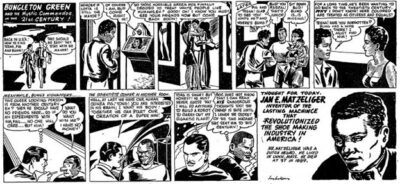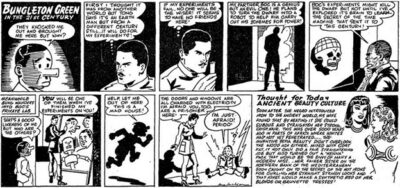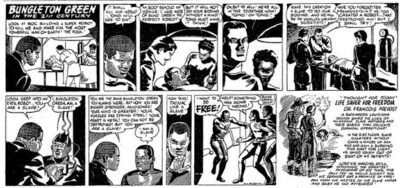Bungleton Green. “the oldest, longest continuously running black comic strip” by Steve Carper
On January 6, 1945, Jay Jackson introduced what is thought to be the first black superhero in comics. Jackson was the head cartoonist for the historic black newspaper, the Chicago Defender, whose editorial cartoons exposed the rampant racism of the time. He also supplied the Defender with a number of comic strips, from the whimsical to stinging social commentary. In 1942, Jackson transformed the Defender’s historic strip, Bungleton Green, into a mixture of both. He removed the setting from contemporary Chicago to a journey through time and space, from a expose of the darkness of slavery in 1778 America to a dystopian future of 2043 where green people oppressed whites as blacks were oppressed even during World War II, supposedly a war for the freedom of all. Some things couldn’t be said directly in wartime America, but setting the commentary in an imaginary future allowed readers to make the connections for themselves. Not at all coincidentally, Jackson had become the first black artist to draw for pulp science fiction magazines when he started illustrating for Amazing Stories in 1938 and absorbed the elements that made the genre compulsively readable.
Jackson also was obviously familiar with the comic books of the day. He looked at the early Superman, who was a crusader against social evils, and at Captain America, whose puny body had been turned into a physical marvel by science, and combined those notions in his title character. On that day in 1945, future scientists take the puny Bungleton Green and recreate his body in a frame as huge as a heavyweight champion’s. They plan to use him as the first of a series of slaves to do their bidding. “Think like a slave,” they tell him. Bung does, but not the way they expect. In a panel as powerful as any in comics history, he throws off their control and yells, “I want to be FREE!”
The superstrong, invulnerable Bungleton Green time travels back to contemporary America, where he battles not supervillains but the everyday gangsters and sharpies who preyed on the black community before traveling to the South and showing how overpoweringly and omnipresently racism there pervaded society. The result is some of the sharpest condemnation of racism to be found in comics of the day, much of it all too relevant still today.
Steve Carper presented the story of the first black superhero in a three-part anniversary series published on the Chicago Defender website. He is a cultural historian who specializes in looking at the ways people in the past saw their Future. He runs the Flying Cars and Food Pills website, which contains an article on Jackson’s pulp sf career, and wrote the definitive book Robots in American Popular Culture, which has a companion website.
https://chicagodefender.com/op-ed-chicago-defender-cartoonist-jay-jackson-and-the-first-black-superhero-pt-1/
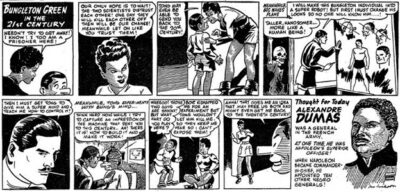
https://chicagodefender.com/op-ed-chicago-defender-cartoonist-jay-jackson-and-the-first-black-superhero-pt-2/
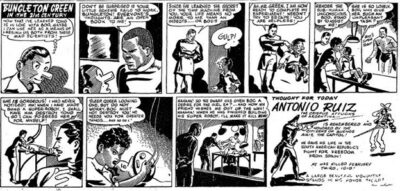
https://chicagodefender.com/op-ed-chicago-defender-cartoonist-jay-jackson-and-the-first-black-superhero-finale/
Join CBH for more discussion at our Facebook group
check out our CBH documentary videos on our CBH Youtube Channel
get some historic comic book shirts, pillows, etc at CBH Merchandise
check out our CBH Podcast available on Apple Podcasts, Google PlayerFM and Stitcher.
Use of images are not intended to infringe on copyright, but merely used for academic purpose.
Images used ©Their Respective Copyright Holders










